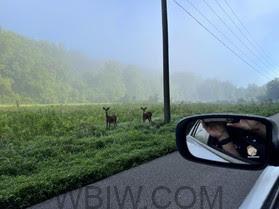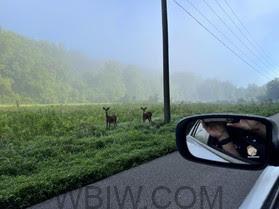
INDIANA – Halloween, pumpkin spice, football…Fall is upon us. But costume parties and football rivalries are not the only things for which we need to prepare. Falling leaves and colder temperatures are making their appearance as well. With these changes come driving hazards more unique to autumn than other times of the year.

According to the Institute of Highway Safety, autumn typically brings a sharp increase in the amount of car versus animal insurance claims, most of those being deer. These claims usually peak in the month of November and decrease through December and January. Wet leaves, colder temperatures, and an increase in rainfall also add to the mix.
Your friends at the Indiana State Police Post in Sellersburg would like to remind you of these tips as you navigate our changing roadways:
- WET LEAVES: Wet leaves can be as slippery as an ice-covered roadway. Drive slowly on leaf-covered roads and avoid hard braking. Also, don’t forget that leaves can obscure lane and roadway markings, so make sure to pay attention to the edge of the roadway and stay in your lane.
- RAIN AND FOG: Wet roads are slippery and may lead to hydroplaning. Increase your following distance, and don’t use cruise control. If it’s foggy, use your low beams or fog lights and avoid using high beams.
- BRIDGES AND OVERPASSES: Any roadway not in direct contact with the ground can freeze quickly. Morning frost can leave icy patches, and shaded areas may remain icy after other parts of the roadway are dry.
According to the National Highway Traffic Safety Administration, there are approximately 1.5 million deer-vehicle collisions each year. According to insurance industry statistics, Indiana usually ranks in the middle of all 50 states and was 24th in 2021 in a car versus animal crashes. In 2021, the odds of a car/animal crash were 1 in 100. West Virginia typically tops the charts with the odds at 1 in 37.
When it comes to our four-legged friends:
- BUCKLE UP! Sudden stops from a collision or even hard braking are common causes of injury. Your seatbelt is the best protection to help prevent you or your passengers from being harmed.
- WATCH FOR SIGNS. Deer crossing signs are there for a reason. Use caution when you see these signs and remember that deer often travel in groups. If you see one, assume more are nearby. Don’t forget to recruit your passengers to assist in looking for deer.
- WHAT TIME IS IT? Deer are active at dawn and dusk as they look for food. This time of year is also their migration and mating season, which is another reason they are more active.
- DON’T SWERVE. If a crash is unavoidable, don’t swerve to avoid hitting the deer. Not only could you swerve into the path of another car, but you could also lose control of your vehicle and possibly roll over. Brake firmly and stay in your lane. Studies show more serious crashes happen when we swerve to avoid an animal.
- I STRUCK A DEER, NOW WHAT? Unfortunately, even if you take all the above precautions, sometimes car/deer crashes are unavoidable. If you do have a collision, remember to move your car off the roadway and call 911 or your nearest police agency. Typically, the comprehensive insurance coverage will cover these crashes, so make sure you contact your insurance agent and, if possible, take photographs of your car and the animal.



